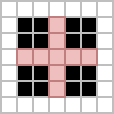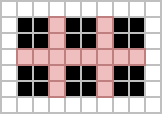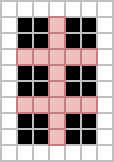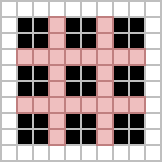Block agar
The block agar is an agar consisting of blocks arranged periodically in rows and columns, with distance of 1 cell between any two adjacent rows or columns. The average field density of the block agar is 4/9.
Sometimes, more sparse arrangements of blocks are also described as block agars.[1]
Reactions in the block agar
|
If an alive cell ("virus") is added to the block agar so that it touches the corners of four blocks, the agar self-repairs in two ticks. However, when a single cell is added so that it touches cells of two different blocks, it initiates an expanding disintegration of the agar.[2][3]
Space clearers for the block agar and for one quarter of the block agar were found by Hartmut Holzwart;[4] these space clearers are reactions that expand through the infinite agar and leave empty space behind.[5]
There are known p3 lightspeed "trimmers" on an array of blocks with zebra stripes boundary.[6]
Finite patches
Finite rectangular patches of the block agar (n-by-m block arrays) are pseudo still lifes; the simplest example is the bi-block, which is the 1 × 2 block array.
| x\y | 1 | 2 | 3 | ... |
|---|---|---|---|---|
| 1 | 
|

|

|
→ |
| 2 | 
|

|

| |
| 3 | 
|

|

| |
| ... | ↓ | ↘ | ||
Glider synthesis
|
In 2005, Jason Summers found a way to extend any 2 × n block array. The method involves building a constellation of beehive and four loaves and hitting it with 8 gliders.[7]
On December 3, 2015, Martin Grant found a method of constructing a 3 × n block array via glider synthesis.[8]
On May 6, 2020, Goldtiger997 found a method of constructing a 4 × n block array.[9]
The problem of constructing an arbitrary m-by-n block array is currently still unsolved.[10][11]
See also
Objects in which a temporary 2 × 2 block array is formed for several consecutive phases:
- 62P83, a C2_1 oscillator
- A C4_1 queen bee shuttle tetramer (Catagolue: here)
References
- ↑ Lifeline Volume 3#Page 29
- ↑ Martin Gardner, Wheels, Life, and Other Mathematical Amusements, The Game of Life, Part II
- ↑ Lifeline Volume 9#Page 6
- ↑ Hartmut Holzwart (July 2, 2020). Re: Agar crawlers (discussion thread) at the ConwayLife.com forums
- ↑ Dave Greene (April 15, 2023). Re: Thread for basic questions (discussion thread) at the ConwayLife.com forums
- ↑ wildmyron (September 21, 2020). Re: 'Skimmers' (discussion thread) at the ConwayLife.com forums
- ↑ 7.0 7.1 Heinrich Koenig (April 20, 2005). "Block Array Constructions". Game of Life News.
- ↑ Martin Grant (December 3, 2015). Re: Synthesising Oscillators (discussion thread) at the ConwayLife.com forums
- ↑ Goldtiger997 (May 6, 2020). Re: Synthesising Oscillators (discussion thread) at the ConwayLife.com forums
- ↑ https://conwaylife.com/forums/viewtopic.php?p=140125#p140125
- ↑ https://conwaylife.com/forums/viewtopic.php?p=146722#p146722